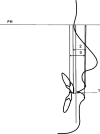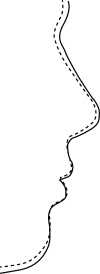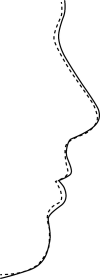The impact of extraction vs nonextraction treatment on soft tissue changes in Class I borderline malocclusions
- PMID: 21932939
- PMCID: PMC8867951
- DOI: 10.2319/051911-339.1
The impact of extraction vs nonextraction treatment on soft tissue changes in Class I borderline malocclusions
Abstract
Objective: To obtain through the use of discriminant analysis a relatively bias-free sample of extraction and nonextraction, Class I, equally susceptible to both treatments' malocclusions and to analyze retrospectively the soft tissue changes between the two different treatment groups.
Materials and methods: The cephalometric, model, and demographic data of 215 patients (females and males) fueled a stepwise discriminant analysis that provided the borderline homogenous subsample (30 extraction and 32 nonextraction cases). The pretreatment and postreatment cephalograms of the borderline sample were then subjected to a thorough soft tissue cephalometric analysis.
Results: The results indicated that the three variables that played the most important role in the clinician's treatment decision were indicators of lower crowding, soft tissue convexity, and lower incisor protrusion. Significant differences (P < .001) regarding upper and lower lip protrusion, upper lip thickness (P < .05), and the nasiolabial angle (P < .05) occurred.
Conclusion: Extraction treatment of Class I borderline malocclusions led to significant soft tissue changes regarding the upper and lower lip position and thickness as well as the nasiolabial angle, whereas the nonextraction treatment resulted in significant upper lip retraction and lower lip protraction.
Figures







Similar articles
-
Comparative evaluation of soft tissue changes in Class I borderline patients treated with extraction and nonextraction modalities.Dental Press J Orthod. 2016 Jul-Aug;21(4):50-9. doi: 10.1590/2177-6709.21.4.050-059.oar. Dental Press J Orthod. 2016. PMID: 27653264 Free PMC article.
-
Effects of extraction and nonextraction treatment on class I and class II subjects.Angle Orthod. 2003 Feb;73(1):36-42. doi: 10.1043/0003-3219(2003)073<0036:EOEANT>2.0.CO;2. Angle Orthod. 2003. PMID: 12607853
-
Comparison of facial soft tissue thickness in subjects with different malocclusions according to the lateral cephalograms of an Iranian adult population.Dent Med Probl. 2025 Mar-Apr;62(2):255-263. doi: 10.17219/dmp/171501. Dent Med Probl. 2025. PMID: 40353371
-
Three-dimensional soft-tissue and hard-tissue changes in the treatment of bimaxillary protrusion.Am J Orthod Dentofacial Orthop. 2013 Aug;144(2):218-28. doi: 10.1016/j.ajodo.2013.03.018. Am J Orthod Dentofacial Orthop. 2013. PMID: 23910203
-
Soft-tissue and dentoskeletal profile changes associated with mandibular setback osteotomy.Am J Orthod Dentofacial Orthop. 1991 Oct;100(4):312-23. doi: 10.1016/0889-5406(91)70068-8. Am J Orthod Dentofacial Orthop. 1991. PMID: 1927981 Review.
Cited by
-
Factors that affect lip changes following incisor retraction in Vietnamese adults with a convex facial profile.J Orthod Sci. 2022 Aug 24;11:40. doi: 10.4103/jos.jos_174_21. eCollection 2022. J Orthod Sci. 2022. PMID: 36188200 Free PMC article.
-
Evaluation of the Changes of the Intercanine and Intermolar Widths Following Palatal Expansion in the Mixed Dentition Patients with Bilateral Posterior Crossbite: A Systematic Review.Dent J (Basel). 2023 Feb 13;11(2):52. doi: 10.3390/dj11020052. Dent J (Basel). 2023. PMID: 36826197 Free PMC article. Review.
-
Tooth extractions in Orthodontics: first or second premolars?Dental Press J Orthod. 2019 Aug 1;24(3):88-98. doi: 10.1590/2177-6709.24.3.088-098.bbo. Dental Press J Orthod. 2019. PMID: 31390455 Free PMC article.
-
Extraction vs nonextraction orthodontic treatment: a systematic review and meta-analysis.Angle Orthod. 2024 Jan 1;94(1):83-106. doi: 10.2319/021123-98.1. Angle Orthod. 2024. PMID: 37899069 Free PMC article.
-
Interproximal wear versus incisors extraction to solve anterior lower crowding: a systematic review.Dental Press J Orthod. 2015 Jan-Feb;20(1):66-73. doi: 10.1590/2176-9451.20.1.066-073.oar. Dental Press J Orthod. 2015. PMID: 25741827 Free PMC article.
References
-
- Marvin C. A. Regulating teeth. Dental Times. 1866;4:97–100, 105–108, 156–160.
-
- Peck H, Peck S. A concept of facial esthetics. Angle Orthod. 1970;40:284–315. - PubMed
-
- Riedel R. A. Esthetics and its relation to orthodontic therapy. Angle Orthod. 1950;20:168–178. - PubMed
-
- Burstone C. J. The integumental profile. Am J Orthod. 1958;44:1–25.
-
- Holdaway R. A. A soft tissue cephalometric analysis and its use in orthodontic treatment planning. Part I. Am J Orthod. 1983;84:1–28. - PubMed
MeSH terms
LinkOut - more resources
Full Text Sources

